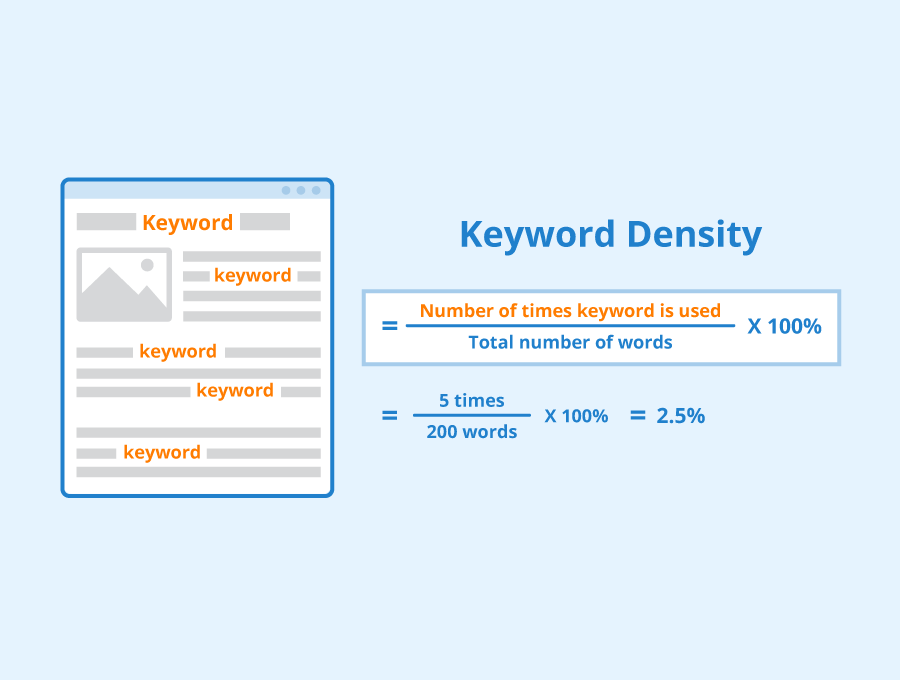Keyword density is crucial for SEO success in 2024. Maintain a balanced approach to avoid keyword stuffing while enhancing readability.
Crafting content with an optimal keyword density can significantly boost your search engine rankings. Aim for a keyword density of 1-2%, ensuring your content remains natural and engaging. Overstuffing keywords can lead to penalties, so focus on quality and relevance.
Use variations and synonyms to maintain flow and context. Integrate keywords organically within headings, subheadings, and body text. This strategy helps search engines understand your content better while providing value to readers. Regularly updating and reviewing your content can keep it fresh and aligned with SEO best practices. Proper keyword density, balanced with quality writing, is key to successful content in 2024.
Introduction To Keyword Density

Understanding keyword density is crucial for effective SEO. It helps your content rank better. This guide on the 2024 Keyword Density will provide you with valuable insights.
What Is Keyword Density?
Keyword density is the percentage of times a keyword appears on a web page. It’s calculated by dividing the number of times the keyword is used by the total word count. Then, multiply by 100.
For example, if a keyword appears 10 times in a 200-word article, the keyword density is 5%.
Here’s a simple formula:
(Number of Keyword Occurrences / Total Word Count) 100
Importance In Seo
Keyword density plays a significant role in SEO. It helps search engines understand your content. Proper keyword density improves your chances of ranking higher.
Here are a few reasons why it’s important:
- Helps search engines understand the topic
- Affects your search engine ranking
- Improves content readability
Balancing keyword density is key. Too low, and your content may not rank. Too high, and it could be flagged as spam.
| Keyword Density | Effect |
| 0-1% | Low relevance |
| 1-2% | Optimal range |
| 3% or more | Risk of being flagged as spam |
Historical Perspective
Understanding the history of keyword density helps in creating effective content today. The journey of keyword density has seen significant changes over the years. This section covers its evolution and compares past and present practices.
Evolution Of Keyword Density
In the early days of SEO, keyword stuffing was a common practice. Websites would fill their content with keywords to rank higher. Search engines were less sophisticated and often fell for this trick.
Gradually, search engines like Google became smarter. They started penalizing websites that used keyword stuffing. This led to a shift in how content creators approached keyword usage.
Today, the focus is on natural keyword integration. High-quality content with relevant keywords ranks better. Search engines now prioritize user experience over keyword density.
Past Vs Present
| Aspect | Past | Present |
| Keyword Usage | High density, repeated keywords | Moderate density, natural integration |
| Content Focus | Keyword-driven | User-driven |
| Search Engine Response | Ranked higher | Penalized for stuffing |
In the past, keywords were the main focus of content creation. Writers aimed to use a high number of keywords. This often led to poor user experience.
Nowadays, content must be engaging and informative. Keywords need to be used naturally. This ensures the content is valuable and ranks well.
Optimal Keyword Density
Understanding keyword density is vital for successful SEO. It helps search engines grasp your content’s focus. In this guide, you will learn the ideal percentage and tools to measure keyword density effectively.
Ideal Percentage
The ideal keyword density is crucial for ranking well. It ensures your content is neither overstuffed nor under-optimized. A good rule is to keep keyword density between 1% and 2%. This means one or two keywords per 100 words of content.
Here’s a simple table to illustrate:
| Word Count | 1% Keyword Density | 2% Keyword Density |
| 100 | 1 keyword | 2 keywords |
| 500 | 5 keywords | 10 keywords |
| 1000 | 10 keywords | 20 keywords |
Tools To Measure
Using the right tools is important to measure keyword density. These tools help ensure your content stays within the optimal range.
- Yoast SEO: A popular WordPress plugin.
- SEMrush: Offers detailed keyword analysis.
- Google Keyword Planner: Useful for finding keyword opportunities.
Each tool has unique features, but all help track keyword usage. Here is a simple code snippet to calculate keyword density manually:
function calculateKeywordDensity(content, keyword) {
let wordCount = content.split(‘ ‘).length;
let keywordCount = content.split(keyword).length – 1;
let density = (keywordCount / wordCount) 100;
return density.toFixed(2) + ‘%’;
}
By following these tips, you can achieve the perfect keyword density for your content in 2024.
Crafting Content For 2024
Creating content for 2024 requires staying current with SEO trends. Understanding keyword density is crucial. It helps improve your ranking on search engines. Let’s explore the trends and strategies for crafting content in 2024.
Trends To Watch
SEO is always evolving. Here are some trends to watch in 2024:
- Voice Search Optimization: More people use voice search. Optimize for natural language.
- AI Content Creation: AI tools help create optimized content. Use them wisely.
- Video Content: Videos engage users more. Include keywords in video descriptions.
- Mobile-First Indexing: Google prioritizes mobile-friendly sites. Ensure your content is mobile-optimized.
- Core Web Vitals: Focus on user experience metrics. Improve page load times and interactivity.
Effective Strategies
Implement these strategies for effective content in 2024:
- Research Keywords: Use tools like Google Keyword Planner. Find relevant keywords.
- Use LSI Keywords: Include Latent Semantic Indexing (LSI) keywords. They improve content relevancy.
- Maintain Keyword Density: Keep keyword density around 1-2%. Avoid keyword stuffing.
- Write Quality Content: Focus on user intent. Provide valuable information.
- Use Headers and Subheaders: Break content into sections. Use H2 and H3 tags effectively.
Here is a quick keyword density guide:
| Word Count | Keyword Frequency |
| 100-300 words | 1-3 times |
| 300-500 words | 3-5 times |
| 500-1000 words | 5-10 times |
By following these trends and strategies, you’ll craft effective content in 2024. Stay updated and keep your content optimized for the best results.
Common Pitfalls
Creating SEO-friendly content involves understanding keyword density. Yet, many fall into common pitfalls. These errors can harm your site’s ranking and readability. Below, we discuss two major pitfalls: Over-Optimization and Keyword Stuffing.
Over-optimization
Over-Optimization occurs when content overly focuses on keywords. This can make the text sound unnatural. Google algorithms can detect this, leading to penalties.
- Avoid using the same keyword too many times.
- Use synonyms to keep the content varied.
- Focus on providing value rather than just keywords.
Here’s an example of over-optimized content:
Our 2024 Keyword Density Guide helps with keyword density. Follow our keyword density tips for better keyword density.
This example repeats the keyword too often. It sounds awkward and unhelpful.
Keyword Stuffing
Keyword Stuffing involves inserting keywords without relevance. This can make your content confusing and spammy. Search engines also penalize this practice.
| Natural Content | Keyword Stuffed Content |
| Our guide offers practical content tips for 2024. | Our 2024 Keyword Density Guide offers keyword density tips. |
Notice how the keyword-stuffed example feels forced. It sacrifices readability for the sake of keywords.
Follow these tips to avoid common pitfalls and create effective content. Focus on clarity and value, not just keywords.
Balancing Readability And Seo
Crafting content that balances readability and SEO is essential. This ensures your content ranks high and engages readers. Achieving this balance involves focusing on user experience and natural language use. Let’s explore these aspects in detail.
User Experience Focus
User experience (UX) is crucial for content success. Readers need to find your content easy to read and navigate. Prioritize short paragraphs, bullet points, and subheadings. This helps break down information and maintains reader interest.
Here are some tips to enhance UX:
- Use simple and clear language.
- Ensure fast page load times.
- Incorporate white space strategically.
- Optimize for mobile devices.
By focusing on UX, you make your content more accessible. This leads to better engagement and retention.
Natural Language Use
Using natural language in your content is vital. It makes your writing sound more human and relatable. Avoid keyword stuffing and write for your audience first.
Consider these strategies:
- Use synonyms and related terms naturally.
- Write in a conversational tone.
- Focus on providing value and answering questions.
- Read your content aloud to ensure it flows naturally.
Natural language use enhances readability and aligns with search engine algorithms. This approach improves both SEO and user satisfaction.
Case Studies
In this section, we dive into real-life case studies of keyword density strategies. These examples show how businesses have effectively used keyword density to enhance their content. You will learn from their successes and mistakes.
Successful Examples
Several companies have mastered the art of keyword density. Let’s look at some notable examples.
| Company | Strategy | Outcome |
| Tech Innovators | Used 1-2% keyword density | Boosted organic traffic by 50% |
| HealthPlus | Maintained 1.5% keyword density | Ranked #1 for target keywords |
| EcoGoods | Kept keyword density under 2% | Increased user engagement by 40% |
Lessons Learned
From these case studies, we learn valuable lessons about keyword density.
- Avoid Keyword Stuffing: Overusing keywords can hurt rankings.
- Maintain Balance: Keep keyword density between 1-2%.
- Focus on Quality: High-quality content attracts more visitors.
These strategies show that careful planning leads to better results. Use these tips to refine your content and achieve similar success.
Future Outlook
The future of keyword density is constantly evolving. As search engines get smarter, so must our content strategies. Understanding what lies ahead can help you stay ahead of the curve and maintain your competitive edge in SEO.
Emerging Trends
Voice Search Optimization: With the rise of smart assistants, voice search is becoming more popular. This trend is shifting how we use keywords. Instead of short keywords, focus on natural language phrases.
AI and Machine Learning: AI algorithms are getting better at understanding context. This means content must be more relevant and valuable. Keywords alone won’t cut it anymore.
Semantic Search: Google’s algorithms now focus on understanding the searcher’s intent. This makes it important to use related terms and synonyms. Don’t just repeat the same keyword.
Predictions For 2025
As we look toward 2025, several changes are likely.
- Increased Importance of User Intent: Search engines will focus more on what the user wants to find. Keywords must align with user queries.
- Content Quality Over Quantity: High-quality content will rank better. Stuffing keywords will hurt your rankings.
- Greater Emphasis on Long-Tail Keywords: These keywords will become more important. They are more specific and less competitive.
- Integration with Visual and Voice Search: Visual and voice searches will continue to grow. Your content must be optimized for these types of searches.
| Year | Focus | Strategy |
| 2024 | Keyword Density | Balance keywords and readability |
| 2025 | User Intent | Optimize for searcher’s needs |
By staying updated on these trends and predictions, you can create content that not only ranks well but also provides value to your audience.
Frequently Asked Questions
What Is The Best Way To Optimize For Keyword Density?
To optimize keyword density, use your main keyword naturally. Aim for 1-2% density. Include variations and related terms. Prioritize readability and user experience.
What Should Be The Keyword Density In 1000 Word Content?
Aim for a keyword density of 1-2%. This means using your keyword 10-20 times in 1000 words.
What Keyword Density Is Good For 500 Words?
A good keyword density for a 500-word article is around 1-2%. This means using your keyword 5-10 times.
Which Ratio Is Best For Keyword Density?
The ideal keyword density is around 1-2%. This means using your target keyword once or twice per 100 words.
Conclusion
Mastering keyword density in 2024 is crucial for content success. Focus on natural integration of keywords. Prioritize readability and user experience. Regularly update and analyze your content strategy. Following these tips will enhance your SEO efforts and drive more organic traffic.
Keep learning and adapting for optimal results.



